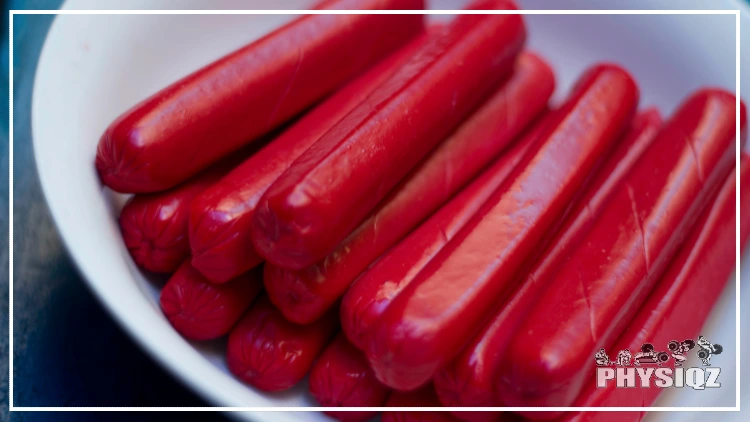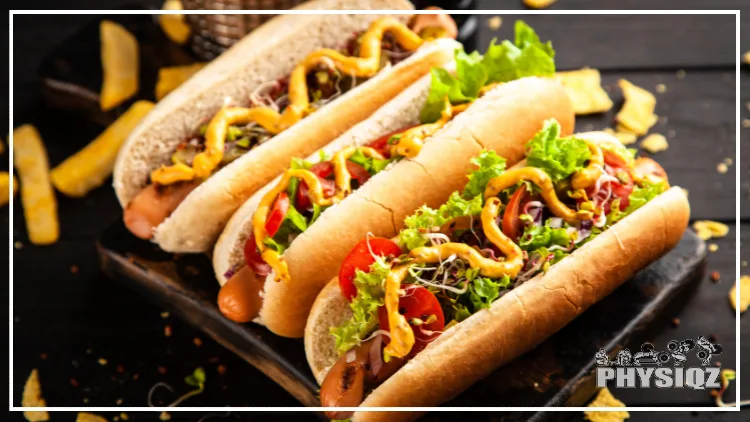
With the keto diet becoming one of the most popular trends in recent years, many people are curious about the compatibility of hot dogs with this diet. The answer varies depending on the hot dog itself, the bun, and the condiments used.1
To understand how to make hot dogs keto, it’s important to first understand what the keto diet is and how it works.
To understand how to make hot dogs suitable for a keto diet, it’s essential to know that keto promotes healthy fats and limits net carbs (total carbs minus fiber) to less than 20-50 grams per day to avoid exceeding the daily carb limit. The carbohydrate content in hot dogs varies, so it’s important to choose those with low carbs or modify them to fit within keto guidelines.
How Many Carbs Are in Hot Dogs?
According to research, limiting carbohydrate intake between 20 and 50 grams of carbs per day can help people achieve and maintain ketosis and the same lies true when we look into hot dogs as a meal.2

Source: Luis Quintero via Canva.com3
Luckily for the keto dieter, hot dogs are not particularly high in carbs, but they can be more calorie-dense than people expect. Most hot dogs contain around 3 grams of carbohydrates each and can surprisingly reach up to 400 calories. Without tracking food intake, this could lead to concerns about maintaining ketosis while not losing weight.
Regardless of caloric density, regular hot dog buns and toppings can quickly turn a hot dog into a carb-heavy meal without careful supervision. Removing these two things won’t allow a person to get into a 1000 calorie deficit, but they can help to reduce carb intake.
Eating Hot Dogs on a Keto Diet: Are They Keto Approved?
While a person can eat solely a hot dog and stay within their carbohydrate requirements to stay in ketosis, consuming a hot dog bun and toppings in tandem is generally not keto-approved.
For example, a standard hot dog bun contains around 22 grams of carbs, while ketchup and mustard each add around 1 gram of carbs per tablespoon, totaling up to over 25 grams of carbohydrates. Combined with the fact that there is little to no dietary fiber in this meal, it is almost certain that eating one hot dog with a bun and some toppings can knock a person out of ketosis.
This is why eating a hot dog recipe on keto requires knowing how to pick a keto bun and keto condiments.
When Hot Dogs Fit into a Keto Diet & Their Ingredients
Hot dogs are only keto-friendly when they are free of fillers and preservatives, and when they are served without a bun or sauce. As aforementioned, a person would need to remove the bun and condiments and choose a brand of hot dog that does not contain fillers or preservatives to ensure that it is actually keto friendly.

Source: benibear via Canva.com4
Removing the bun and condiments from a hot dog can significantly reduce its calorie content, providing a potential method for those looking to lose weight quickly.
But, that aside, as long as a person doesn’t eat their hot dogs on a hot dog bun or with high-sugar condiments like ketchup, it is quite simple to create a keto-friendly hot dog.
Hot dogs can be considered keto-friendly when the bun and condiments are low in net carbs, and the hot dog itself contains no fillers.
Nathan’s Hot Dogs meet these requirements, and we’ll go over low carb condiments and buns in a moment too. Additionally, Nathan’s hot dogs are both keto-friendly and delicious.
Hot Dogs Ingredients in Relation to Keto
Hot dogs are typically made from beef, pork, or a combination of the two. Most hot dogs also contain preservatives, spices, and fillers. While the meat in hot dogs is keto-friendly, the other ingredients are not. To make a keto-friendly hot dog, typically, the bun and condiments would need to be removed. Afterward, choose a brand of hot dog that is free from fillers or preservatives.
In general, fillers and preservatives are quite hard to track and may make it impossible to accurately track carb intake. Some common fillers include:
- Sodium diacetate: A combination of sodium acetate and acetic acid, the primary purpose of this filler is as an antimicrobial agent and pathogen inhibitor. Frankly, if food needs a chemical injected into it to stop pathogens from growing, it might be a good idea to stray away from foods containing it.
- Sodium erythorbate: This is mainly used as a preservative and keeps the hot dogs maintaining their famous red brown tone, but some people report gastrointestinal issues with sodium erythorbate as the main cause.
- Maltodextrin: A polysaccharide made from corn that is used as a food additive, it is easily digestible and has a high glycemic index, which can quickly raise blood sugar levels; remember, the point of being on keto is to maintain blood sugar levels, so consuming an additive that spikes it is a big no-no.
- Sodium nitrite: This is probably the most famous of all the hot dog ingredients, and for good reason. Multiple studies argue sodium nitrites are significantly tied to the development of colorectal cancer (CRC), and there is currently little evidence to refute that.5
- Potassium lactate: The FDA allows the use of potassium lactate as a flavoring agent, pathogen growth inhibitor, and pH control agent in various foods; it should go without being said that the reader should pass their judgment on this chemical.
- Corn syrup: Last but certainly not least, corn syrup is used as a thickener and sweetener in hot dogs, potentially adding volume or even softening the texture slightly.
While it has little nutritional value, its cousin, high-fructose corn syrup, has a very strong correlation with obesity in America.6 That being said, while HFCS isn’t used in hot dogs, corn syrup is, and it would probably be a good idea to stray away from hot dogs with corn syrup in them.
Top 3 Keto-Friendly Hot Dog Brands
There are a few brands of hot dogs that are keto-friendly. These brands typically use high-quality meat and do not contain any fillers or preservatives. Some of the top keto-friendly hot dog brands include:
- Applegate Farms: Applegate Farms’ hot dogs are made from 100% grass-fed beef and do not contain any fillers, artificial ingredients, or preservatives. They pride themselves on being the best hot dog brand in the industry for good reason: according to their website, they never use antibiotics or hormones and have an extremely high standard for raising animals for their hot dogs.7
- Organic Valley: Organic Valley’s Grass-Fed Beef hot dogs are made from, as the name suggests, grass-fed beef. They are also free of fillers, artificial ingredients, and preservatives. Their website is very clear about what goes into their hot dogs, which is always a good sign.
- Hebrew National: Hebrew National hot dogs are made from 100% pure kosher beef and are free of fillers, artificial ingredients, or preservatives. These hot dogs are renowned for being very hearty in flavor.
Keto Approved Hot Dog Toppings & Condiments
When most people consider the keto-friendliness of hot dogs, they often focus on the bun and various toppings that don’t fit into the keto diet.

Source: George Dolgikh via Canva.com8
However, there are a few keto-friendly hot dog toppings and condiments available on the market. These hot dog toppings and condiments tend to be low-carb due to being made with no sugar or low-carbohydrate ingredients like chicory root fiber.
Low Carb Hot Dog Toppings
- Low-carbohydrate hot dog buns: There are quite a few keto-friendly hot dog buns available on the market. These are typically made from low-carb ingredients like almond flour or coconut flour, which simultaneously add some extra fiber and protein to the macronutrient profile. Some buns are made with wheat protein but contain lots of fiber to reduce the net carb count.
- Sugar-free pickle relish: There are a few brands of sugar-free pickle relish available on the market. These brands typically use artificial sweeteners such as sucralose or Stevia to sweeten their pickle relish.
- Cheese: This may sound like a weird one, but a lot of people are fans of cheese on their hot dogs. Chili cheese dogs are very popular, after all, and they do fit exactly into the keto diet (minus the beans and non-keto bun, of course).
Keto Condiments For Hot Dogs
- Sugar-free ketchup: There are a few brands of sugar-free ketchup available on the market. These brands typically use artificial sweeteners such as sucralose or Stevia to sweeten their ketchup.
- Mustard: In general, mustard is a condiment that is already keto. Mustard seed is extremely low in calories and contains no sugar by default, but for mustard varieties like honey mustard, be aware that it may contain added sugar to get that honey flavor.
- Sugar-free BBQ sauce: Similar to cheese, many people do not consider barbecue sauce when thinking about condiments to put on their hot dogs. But, sugar-free BBQ sauce is a fantastic addition; it adds a lot of flavor and depth to an already hearty-tasting piece of meat.
The 3 Best Low Carb Hot Dog Buns
As discussed in this article, hot dogs can be included in a keto diet. However, the carbohydrate count in standard hot dog buns often raises concerns about their compatibility with keto guidelines. To address this, keto-friendly hot dog buns were developed.
Keto hot dog buns, as aforementioned, are usually made from low-carbohydrate ingredients like almond flour or coconut flour. These are ingredients that have significantly fewer carbohydrates than standard wheat flour, and also have a very low impact on blood sugar levels, which is perfect for keto: those who are observed in ketosis typically have very low blood glucose levels.9
The top three best low-carb hot dog buns were picked due to a variety of reasons. The first reason is the bun’s taste. All three buns were soft, fluffy, and had a flavor that was not overpowering. The second reason is the macronutrient makeup of the bun. All three buns are very low in net carbohydrates and are also high in fiber and protein. The third reason is the price of the bun. All three buns are priced similarly and are affordable.
- Franz Bakery Keto Hot Dog Buns: Franz Bakery Keto Hot Dog Buns are surprisingly not made with almond or coconut flour, but are instead made primarily with wheat, oats, and chicory fiber. Only tallying in at 50 calories with 15 grams of fiber, there is 1 gram of net carbs total. For those who want to be in a calorie deficit without exercise, these buns are ideal.
- Sola Low Carb Golden Wheat Hot Dog Buns: Sola’s Low Carb Hot Dog Buns are made with a combination of wheat, olive oil, arrowroot flour, soy flour, and various seeds like sunflower and flax to add fiber. These buns are certainly higher in calories, with each one containing 180 calories, 10 grams of fat, 14 grams of protein, 11 grams of fiber, and 8 grams of net carbs. For those who believe they can eat freely if they work out, these buns are ideal due to their high protein content and caloric density.
- Hero Bread Hot Dog Buns: Similar to the previous two keto hot dog buns, the Hero Bread Hot Dog Buns are made primarily with wheat, but also contain canola oil, flaxseed, fava bean protein, and pea protein. At half the calories of Sola’s offering, these buns are 90 calories each with 4 grams of fat, 10 grams of protein, 21 grams of fiber, and 1 gram of net carbs.
Example of Keto Hot Dog With Topping & Condiment Recipe
Honestly, it is extremely simple to make a keto hot dog recipe. All it requires is a hot dog with no preservatives or fillers, a keto hot dog bun, and a keto sauce or two. One example could be an Applegate Farms Hot Dog on a Hero Bread Hot Dog Bun with sugar-free ketchup.
There is even the potential to eat the hot dog bunless with a sugar-free condiment to make it keto; think of a sliced hot dog with sugar-free BBQ sauce. Or, to get even weirder, think about the times when kids argued that eating hot dogs in macaroni and cheese was a good idea.
There is technically the potential to create a mac and cheese with low-carb noodles, like chickpea pasta, and add a hot dog to it to up the protein and fat amount. This meal would not be for someone who is following the 3 steps to lose weight; this would probably be for someone looking to gain weight.
Hot dogs can be a simple and fast meal, and there is even the potential to use them in weird ways when on the keto diet. With the availability of numerous keto-friendly hot dog buns and sugar-free condiments, determining whether hot dogs fit into a keto diet becomes straightforward.
Frequently Asked Questions
How Many Hot Dogs Are Suitable for a Keto Diet?
There is no definitive answer to this question as it depends on each individual’s daily carb intake allowance. However, generally speaking, most people following a keto diet can eat 1-2 hot dogs per day without going over their daily carb allotment.
What Is The Nutritional Value Of A Hot Dog?
According to the U.S. Department of Agriculture, 100 grams of hot dog accounts for 211 calories, 19 grams of protein, 14 grams of fat, and 2 grams of carbohydrates. For a keto diet, it is best to lean into higher fat and protein foods, so hot dogs are a good item to eat while on keto.
References
1vandervelden. Canva. Accessed 13 April 2023. <https://www.canva.com/photos/MAEEExW45Hs-messy-glutton-eating-several-hotdogs/>
2Abbasi, J. (2018). Interest in the Ketogenic Diet Grows for Weight Loss and Type 2 Diabetes. Journal of the American Medical Association, 319(3), 215-217. <https://pubmed.ncbi.nlm.nih.gov/29340675/>
3Quintero, Luis. Canva. Accessed 13 April 2023. <https://www.canva.com/photos/MADyRT2Dvnw-close-up-photo-of-skewered-sausage-on-tray/>
4benibear. Canva, 13 December 2011. Accessed 13 April 2023. <https://www.canva.com/photos/MACaX-CG-ow-hotdog-sausages-on-a-plate/>
5Crowe, W., Elliott, C. T., & Green, B. D. (2019). A Review of the In Vivo Evidence Investigating the Role of Nitrite Exposure from Processed Meat Consumption in the Development of Colorectal Cancer. Nutrients, 11(11), 2673. <https://www.ncbi.nlm.nih.gov/pmc/articles/PMC6893523/>
6Bray, G. A., Nielsen, S. J., & Popkin, B. M. (2004). Consumption of high-fructose corn syrup in beverages may play a role in the epidemic of obesity. American Journal of Clinical Nutrition, 79(4), 537-43. <https://pubmed.ncbi.nlm.nih.gov/15051594/>
7Applegate Farms. (2022). Animal Welfare. Applegate. Retrieved October 26, 2022, from <https://applegate.com/mission/animal-welfare>
8Dolgikh, George. “Three delicious hotdogs.” Canva, 13 December 2011. Accessed 13 April 2023. <https://www.canva.com/photos/MADYNU2esPU-three-delicious-hotdogs/>
9Dasthi, H. M., Matthew, T. C., Hussein, T., Asfar, S. K., Behbahani, A., Khoursheed, M. A., Al-Sayer, H. M., Bo-Abbas, Y. Y., & Al-Zaid, N. S. (2004). Long-term effects of a ketogenic diet in obese patients. Experimental & Clinical Cardiology, 9(3), 200-205. <https://www.ncbi.nlm.nih.gov/pmc/articles/PMC2716748/>